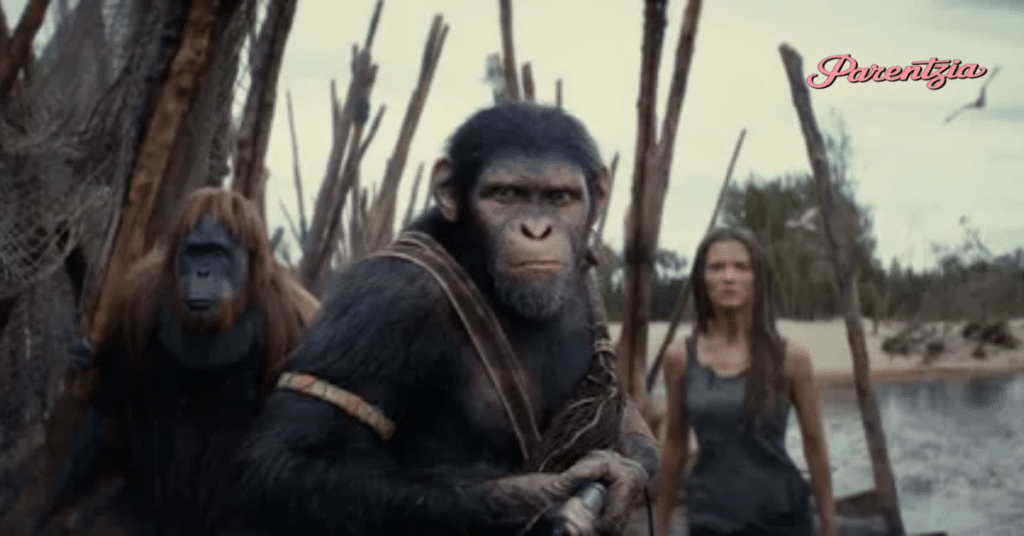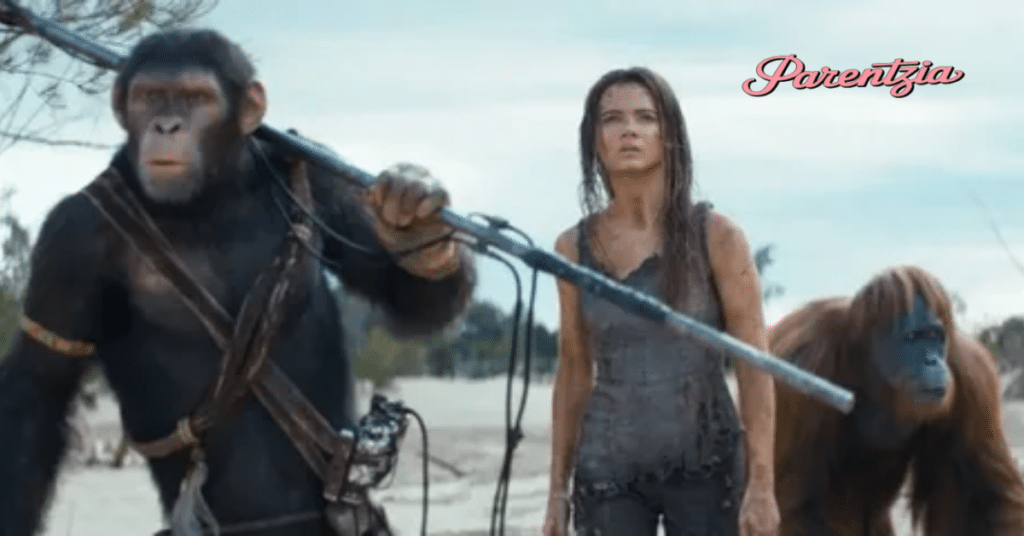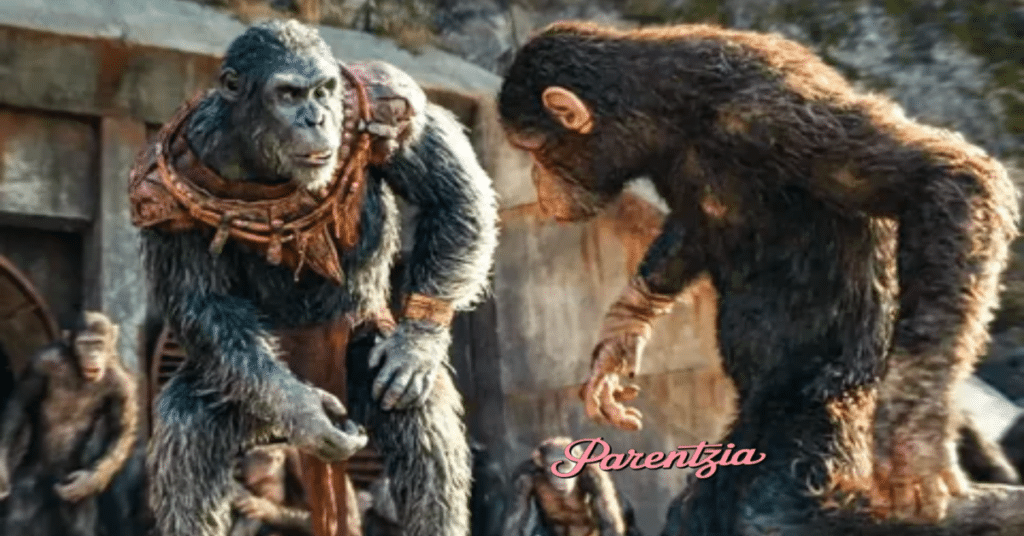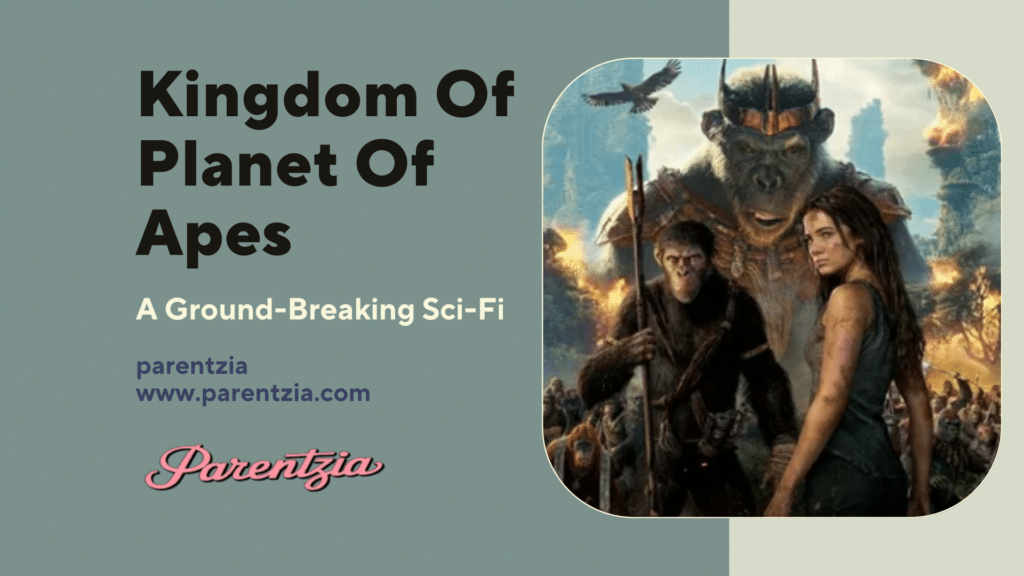A deep dive into Disney’s latest Planet of the Apes installment – exploring how this sci-fi film sequel pushes boundaries while honoring its roots.
The Dawn of a New Era
The Kingdom of the Planet of the Apes transports us 300 years beyond the world we knew, landing in a future where Earth’s landscape has transformed beyond recognition. This latest chapter in the beloved franchise doesn’t just continue the story – it revolutionizes it. As a parent movie review, it’s worth noting upfront that the film carries a PG-13 age rating, balancing intense action with thought-provoking themes suitable for teenage viewers and adults alike.
“We’re exploring what happens when Caesar’s legacy becomes mythology.” – Wes Ball, Director
Quick Facts:
- Release Date: May 10, 2024
- Director: Wes Ball
- Runtime: 2 hours 25 minutes
- Budget: $200 million
- Filming Locations: Australia and New Zealand

You might also like “The Wild Robot: Ultimate Parent’s Guide“
Visual Spectacle That Pushes Boundaries
The post-apocalyptic Earth of 2950 is a sight to behold. Kingdom of the Planet of the Apes showcases:
- Overgrown cityscapes reclaimed by nature
- Stunning natural vistas that emphasize Earth’s rebirth
The visual effects team, led by industry veteran Dan Glass, has outdone themselves. The motion capture technology has evolved significantly since the previous trilogy:
| Aspect | War (2017) | Kingdom (2024) |
| Facial Expressions | 1,000 points tracked | 3,000+ points tracked |
| Fur Detail | 2 million strands | 5 million+ strands |
| Rendering Time | 20 hours per frame | 8 hours per frame |
Character Deep Dive
Noa: A New Kind of Hero
Owen Teague brings depth and nuance to Noa, an adventurous young ape who questions the oppressive regime of Proximus Caesar. His performance captures:
- Internal conflict between loyalty and justice
- Physical prowess in breathtaking action sequences
- Subtle facial expressions that convey complex emotions

Proximus Caesar: A Tyrant Born from Legacy
Kevin Durand’s portrayal of the antagonist is chilling. His character represents:
- The corruption of Caesar’s teachings
- A cautionary tale about power and fear
- A complex villain with understandable, if misguided, motivations
Human Characters in an Ape World
Freya Allan’s Mae brings a crucial human perspective to the story. Their role highlights:
- The resilience of humanity
- The potential for cooperation between species
- A bridge between the franchise’s past and future
Thematic Analysis
The film explores several profound themes:
Power and Corruption
- The rise of authoritarian leadership in ape society
- How fear can be weaponized to control populations
- The importance of questioning authority
Legacy and Mythology
- Caesar’s teachings transformed into religious doctrine
- The danger of blindly following historical figures
- How time can distort even the noblest intentions
Nature vs. Technology
The movie presents a fascinating dichotomy:
- Apes advancing technologically while maintaining connection to nature
- Humans regressing yet retaining knowledge of advanced technology
- The balance between progress and preservation

Technical Achievements
Wes Ball’s Direction
Ball brings his dynamic visual style to the Planet of the Apes franchise:
- Seamless integration of practical and digital effects
- Long, unbroken shots that immerse viewers in the action
- Intimate character moments that ground the spectacle
Cinematography and Sound
- Cinematographer Gyula Pados creates a visual language that distinguishes between ape and human perspectives
- Music composer Pinar Toprak’s score blends tribal elements with orchestral grandeur
- Sound design that brings the world to life, from rustling leaves to ape vocalizations
Franchise Connections
True fans will appreciate the thoughtful callbacks:
- Nova’s compass from the original 1968 film appears as a crucial plot device
- Several locations from previous films are revisited, now transformed by time
- Careful attention to continuity in ape culture and development
Easter Eggs Table
| Reference | Context | Significance |
| School Ruins | Scene where Noa discovers human artifacts | Callback to Caesar’s childhood |
| Alpha-Omega Symbol | Appears on ancient weapons | Links to Colonel McCullough’s army |
| Sierra Mountains | Key location in third act | Site of Caesar’s final battle |
Critical Analysis
Strengths:
✅ Groundbreaking visual effects ✅ Complex, morally ambiguous characters ✅ Thought-provoking themes ✅ Respect for established lore
Areas for Improvement:
⚠️ Some pacing issues in the second act ⚠️ A few underdeveloped supporting characters ⚠️ Occasional over-reliance on exposition
The Verdict
Kingdom of the Planet of the Apes isn’t just another sequel – it’s a reinvention that respects its roots while blazing new trails. This Disney Planet of the Apes production proves that blockbuster spectacle and thoughtful storytelling can coexist.
Rating Breakdown:
- Story: 9/10
- Visual Effects: 10/10
- Performances: 9/10
- Direction: 9/10
- Overall: 9.2/10
Who Should Watch?
- Fans of the previous films
- Sci-fi enthusiasts
- Viewers who appreciate thought-provoking action
- Families with teenagers (mindful of the PG-13 age rating)
Looking Ahead
As this sci-fi film sequel sets new standards for the franchise, it also opens up exciting possibilities for future installments. With strong box office predictions and critical acclaim, the Planet of the Apes saga seems poised to continue its evolution as one of cinema’s most thought-provoking and visually stunning series.
Whether you’re a longtime fan or new to the franchise, Kingdom of the Planet of the Apes offers an unforgettable journey into a world where the lines between human and ape, right and wrong, past and future, blur in the most fascinating ways.

Tina Grey is an experienced blogger with a passion for uncovering the best in film. With years of writing and a keen eye for detail, Tina brings insightful reviews and engaging content to Parentzia. Her deep love for movies, combined with her expertise, helps readers discover must-watch films across genres. When she’s not reviewing, Tina enjoys exploring new cinematic trends and sharing her love of film with her audience.







